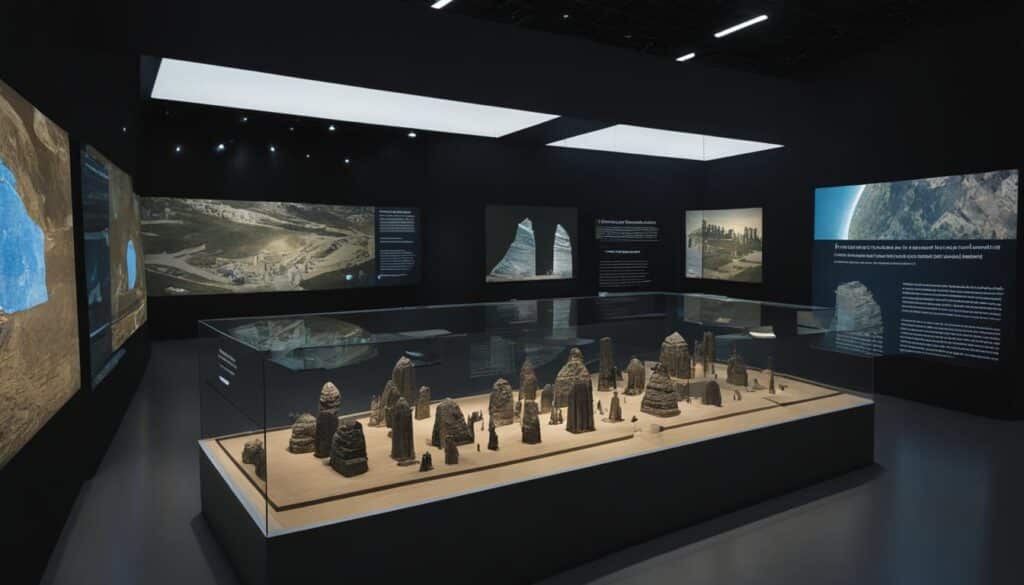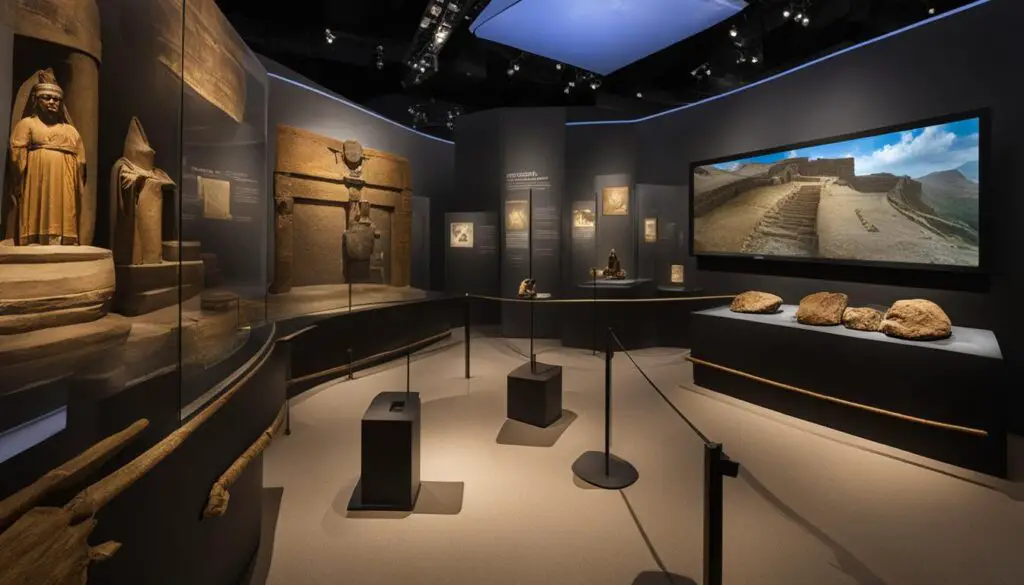
I am excited to explore the fascinating world of virtual museum exhibits and their impact on biblical finds. These online experiences have revolutionized the way we engage with ancient artifacts, providing us with a unique opportunity to delve into the rich history and significance of these treasures.
Virtual museum exhibits have become increasingly popular in recent years, driven by technological advancements and the need for alternative ways to connect with historical artifacts, especially during the COVID-19 pandemic. Through immersive online experiences, these exhibits offer a convenient and interactive platform to explore and learn about biblical finds, right from the comfort of our own homes.
Key Takeaways:
- Virtual museum exhibits are revolutionizing the exploration of biblical finds.
- These exhibits provide an immersive and interactive experience.
- Virtual exhibits are accessible from anywhere in the world.
- They offer a comprehensive exploration of artifacts with multimedia features.
- Research and education are greatly enhanced through virtual exhibits.
The Rise of Virtual Museum Exhibits
In recent years, there has been a significant rise in the popularity of virtual museum exhibits. Through immersive online experiences, these exhibits allow users to virtually walk through galleries, explore artifacts in detail, and access educational resources about biblical finds.
This shift towards virtual platforms has been driven by technological advancements, increased accessibility, and the need for alternative ways to engage with historical artifacts, especially during the COVID-19 pandemic. Virtual museum exhibits provide a convenient and interactive way to connect with biblical finds, regardless of geographical location.
Advancements in Technology
The rapid advancements in technology have played a crucial role in the rise of virtual museum exhibits. High-quality graphics, 3D modeling, and interactive features provide users with a realistic and engaging experience. Through virtual reality (VR) and augmented reality (AR), users can explore digital replicas of artifacts, allowing for a deeper understanding of their historical context.
Increased Accessibility
Virtual museum exhibits have significantly increased accessibility to biblical finds. No longer limited by physical distance or travel restrictions, individuals from all over the world can explore these exhibits with just a few clicks. This accessibility opens up opportunities for education, research, and cultural exchange that were previously limited to a select few.
Alternative Engagement During the Pandemic
“Virtual museum exhibits have become a lifeline for individuals seeking cultural experiences during the pandemic. With traditional museums closing their doors, online experiences have provided a way to continue engaging with history and the arts.”
The COVID-19 pandemic has disrupted traditional museum visits and physical exhibitions. As a result, virtual museum exhibits have become a lifeline for individuals seeking cultural experiences. These online platforms offer a safe and engaging way to continue exploring biblical finds, even when physical access is restricted.
Virtual museum exhibits not only offer an alternative during the pandemic but also provide a glimpse into the future of museum experiences. As technology continues to advance, these online platforms will become more immersive, interactive, and accessible, revolutionizing the way we engage with historical artifacts.
Advantages of Virtual Museum Exhibits
Virtual museum exhibits offer several advantages over traditional museum visits:
- Accessibility: Virtual exhibits can be accessed from anywhere in the world, eliminating geographical constraints.
- Convenience: Users can explore exhibits at their own pace, anytime, and from the comfort of their own homes.
- Interactivity: Virtual exhibits often include interactive features that enhance the learning experience, such as zooming in on artifacts or accessing additional information.
- Education: Detailed descriptions and educational resources accompany virtual exhibits, providing in-depth knowledge about biblical finds.
These advantages make virtual museum exhibits a valuable tool for education, research, and cultural preservation.
Exploring Biblical Finds Through Virtual Exhibits
Virtual museum exhibits provide a wide range of opportunities to explore and learn about biblical finds. These immersive online experiences allow users to navigate through digital galleries, zoom in on artifacts for a closer look, and access detailed descriptions and historical context.
One of the key advantages of virtual exhibits is the inclusion of multimedia features that enhance the learning experience. Interactive maps enable users to trace the ancient routes taken by biblical figures, bringing the stories to life. 3D models allow for a deeper understanding of the intricate details of artifacts, offering a level of exploration that may not be possible in traditional museum visits.
“Virtual exhibits make it possible to examine ancient manuscripts, view archaeological discoveries, and study religious artifacts with unprecedented access and engagement,” says Dr. Elizabeth Cohen, a renowned biblical historian.
Whether you’re interested in examining the historical significance of ancient manuscripts or delving into the mysteries of archaeology, virtual exhibits offer a comprehensive and engaging exploration of biblical finds. They provide a unique platform for both scholars and enthusiasts alike to dive deeper into the world of biblical history.
By harnessing the power of technology, virtual exhibits go beyond static displays and traditional museum limitations. These exhibits cater to a diverse range of learning styles and preferences, offering a dynamic and interactive experience. Users can listen to audio recordings of religious texts, watch video presentations on biblical topics, and interact with experts through live webinars or Q&A sessions.
Digital Galleries and Artifacts
Virtual exhibits enable users to explore an extensive collection of biblical artifacts within digital galleries. These galleries can be organized thematically, geographically, or chronologically, allowing users to navigate through a curated selection of artifacts with ease. Each artifact is accompanied by detailed descriptions, providing valuable context and historical insights.
Take, for example, the virtual exhibit “Treasures of the Holy Land.” This exhibit presents a curated collection of artifacts from sites in Israel and the surrounding regions, showcasing the cultural diversity and historical significance of biblical finds.

Virtual Tours and Interactive Features
In addition to digital galleries, virtual exhibits often offer virtual tours of ancient sites and archaeological digs. Through high-resolution images, users can explore these sites as if they were on location. Virtual tours provide a sense of immersion and enable users to gain a better understanding of the historical context surrounding biblical finds.
Interactive features further enhance the exploration process. Users can engage with multimedia content, such as 3D reconstructions of ancient cities or video presentations that delve into specific aspects of biblical history. These interactive elements provide a multisensory learning experience that caters to various learning styles.
“Virtual exhibits offer a unique opportunity to experience the world of biblical finds with unprecedented accessibility and interactivity,” says Dr. David Thompson, an archaeologist specializing in biblical archaeology.
Whether you’re a student, a scholar, or an individual with a general interest in biblical history, virtual exhibits provide an immersive and informative platform for exploring biblical finds. These exhibits bridge the gap between traditional museum visits and the digital age, expanding our understanding of ancient texts, artifacts, and their cultural significance.
Advantages of Virtual Museum Exhibits
Virtual museum exhibits offer a multitude of advantages compared to traditional museum visits. The digital nature of these exhibits provides accessibility that knows no bounds, allowing individuals from all corners of the world to explore and appreciate biblical finds. Regardless of geographical constraints, virtual exhibits break down barriers, making it possible for anyone with an internet connection to embark on a virtual journey through ancient artifacts. This level of accessibility expands the reach of these exhibits, making them available to a global audience.
One of the most significant advantages of virtual exhibits is the convenience they offer. Unlike traditional museum visits that are bound by operating hours and physical location, virtual exhibits are accessible 24/7. Users can explore biblical finds at their own pace and convenience, without the limitations of time or travel. Whether it’s in the early morning or late at night, virtual exhibits provide the flexibility to engage with these artifacts whenever it suits the user.
Virtual exhibits also enhance the learning experience through interactive features and educational resources. These exhibits go beyond static displays and offer dynamic elements that promote a deeper understanding of the historical and cultural significance of biblical finds. Users can engage with multimedia features, such as interactive maps, 3D models, and audiovisual presentations, enabling a comprehensive exploration of the artifacts. The interactive nature of virtual exhibits fosters an immersive learning environment, where users can delve into the details and context of each artifact. This interactive approach facilitates a more enriching and enlightening experience for users, allowing them to connect with the artifacts on a deeper level.
“Virtual museum exhibits break down barriers, making it possible for anyone with an internet connection to embark on a virtual journey through ancient artifacts.”
Furthermore, virtual exhibits provide an inclusive experience for all users, regardless of their background or physical location. These exhibits can be accessed on various devices, including computers, tablets, and smartphones, ensuring compatibility with a wide range of technology. The accessibility of virtual exhibits extends to users with disabilities, as these exhibits can be made compliant with accessibility guidelines. By prioritizing accessibility, virtual exhibits ensure that everyone, regardless of their abilities, can engage with and appreciate biblical finds.
Overall, the advantages of virtual museum exhibits are numerous. The accessibility, convenience, and immersive nature of these exhibits provide a unique and enriching experience for users worldwide. Through the use of cutting-edge technology, virtual exhibits transcend physical limitations, opening up a world of exploration and knowledge for all who seek to uncover the wonders of biblical finds.
Notable Virtual Museum Exhibits of Biblical Finds
Several notable virtual museum exhibits focus specifically on biblical finds. These exhibits showcase a variety of artifacts, including ancient manuscripts, archaeological discoveries, and religious artifacts. Examples of such exhibits include:
- The Dead Sea Scrolls Online
- The Holy Land Archaeology Project
The “The Dead Sea Scrolls Online” exhibit provides users with the opportunity to explore and study the famous Dead Sea Scrolls. Through this virtual experience, users can examine the intricate details of these ancient manuscripts and gain insights into their historical and cultural significance. It offers a unique glimpse into one of the most significant discoveries in biblical archaeology.
The “The Holy Land Archaeology Project” offers a detailed virtual tour of archaeological sites in the Holy Land. Users can virtually navigate these sites, explore artifacts, and learn about the rich history and archaeological findings associated with biblical events. This exhibit provides a comprehensive and immersive experience that brings the biblical story to life.
These virtual exhibits allow individuals to engage with biblical finds in a way that transcends physical boundaries. Through interactive features, detailed descriptions, and multimedia presentations, users can dive deep into the world of biblical archaeology and gain a deeper understanding of its importance. With the convenience and accessibility of virtual platforms, these exhibits offer an enriching experience for both scholars and enthusiasts.
| Exhibit Name | Description |
|---|---|
| The Dead Sea Scrolls Online | Explore and study the famous Dead Sea Scrolls in an immersive virtual environment. |
| The Holy Land Archaeology Project | Take a virtual tour of archaeological sites in the Holy Land to learn about biblical events and artifacts. |
Impacts of Virtual Museum Exhibits on Education and Research
Virtual museum exhibits of biblical finds have made a profound impact on education and research. These innovative digital experiences provide students, researchers, and scholars with valuable resources to engage with and analyze biblical artifacts in unprecedented ways.
The accessibility and interactive features of virtual exhibits have revolutionized the learning and research process. Students can now explore biblical finds with ease, delving deep into their historical and cultural significance. Through virtual exhibits, researchers gain the ability to examine and analyze artifacts from various angles, unlocking new insights and perspectives.
One of the key advantages of virtual exhibits is their ability to break down geographical barriers. Researchers and academics from different parts of the world can collaborate and exchange knowledge and ideas, fostering a global community of experts. This collaboration enables a more comprehensive and diverse exploration of biblical finds, enriching the field of research.
Moreover, virtual museum exhibits offer an immersive and engaging educational experience. Students can interact with artifacts in virtual galleries, zoom in for close-ups, and access detailed descriptions and historical context. The interactivity fosters active learning and deepens the understanding of biblical finds.
“Virtual exhibits have transformed the way we study and appreciate biblical artifacts. Through these digital experiences, students can engage directly with the artifacts and gain a deeper understanding of their historical context and significance.”
– Dr. Emily Thompson, Archaeology Department, University of New York
Furthermore, virtual exhibits contribute to the preservation and accessibility of biblical finds. These digital platforms enable curators to share rare and fragile artifacts with the public, while ensuring their long-term preservation. Virtual exhibits provide an alternative means for individuals across the globe to explore and appreciate these valuable artifacts, regardless of physical location or travel restrictions.
The Impact of Virtual Exhibits on Research
Virtual museum exhibits have vastly expanded the research possibilities for biblical finds. Researchers can now study artifacts without the limitations of time and space, accessing digital reproductions whenever necessary. This accessibility allows for more extensive analysis and comparison of artifacts, leading to deeper insights and discoveries.
The collaboration facilitated by virtual exhibits brings together researchers with diverse expertise, enabling interdisciplinary study and research. Scholars from archaeology, history, theology, and other fields can share their knowledge and perspectives, contributing to a more holistic understanding of biblical finds.
Moreover, virtual exhibits provide opportunities for cutting-edge research techniques. With technologies such as 3D scanning and virtual reality, researchers can conduct digital reconstructions, intricate examinations, and virtual simulations. These tools open new avenues for analyzing artifacts and investigating their historical contexts.
The Impact of Virtual Exhibits on Education
Virtual museum exhibits have transformed the way education engages with biblical finds. Students now have a wealth of visual resources at their fingertips, allowing for more dynamic and interactive learning experiences. The multimedia features of virtual exhibits, such as interactive maps, 3D models, and audiovisual presentations, enhance student engagement and comprehension.
Virtual exhibits also contribute to inclusive education. Students with limited physical access to museums or those with disabilities can now explore biblical finds on equal footing with their peers. The virtual environment removes barriers and ensures that all students have the opportunity to engage with these historical treasures.
In addition, virtual exhibits enable educators to personalize the learning experience. Teachers can curate content that aligns with specific lesson plans, creating tailored educational journeys for students. The interactive nature of virtual exhibits allows students to actively participate in their own education, promoting critical thinking and a deeper understanding of biblical finds.
“Virtual exhibits have revolutionized the way we teach biblical history. Students can now immerse themselves in the artifacts, bringing the past to life right in the classroom.”
– Sarah Parker, High School History Teacher
| Impact on Education | Impact on Research |
|---|---|
| Enhanced engagement and interactivity | Expanded access to artifacts |
| Inclusive education for all students | Facilitated collaboration among researchers |
| Personalized learning experiences | Opportunities for interdisciplinary study |

Conclusion
Virtual museum exhibits have revolutionized the way we engage with biblical finds, providing immersive experiences that bring these artifacts to life. With the advancements in technology and the increasing accessibility of virtual platforms, these exhibits offer a new home for ancient scripture, allowing us to explore and understand their historical significance in ways that were previously unimaginable.
Through virtual museum exhibits, we can now navigate digital galleries, examine artifacts in detail, and access multimedia features that enhance our learning experience. From ancient manuscripts to archaeological discoveries, virtual exhibits provide a comprehensive and interactive platform to explore and appreciate biblical finds.
One of the key advantages of virtual exhibits is their accessibility. Regardless of our geographical location, we can access these exhibits from the comfort of our own homes, eliminating the constraints of physical distance. The convenience of 24/7 availability further enhances our ability to engage with these artifacts on our own time.
As virtual exhibits continue to evolve, they will undoubtedly play a crucial role in preserving and sharing the rich history and cultural heritage of biblical finds. By providing immersive experiences and expanding educational resources, virtual museum exhibits contribute to a deeper understanding of ancient scripture and ensure that these treasures are accessible to a global audience.
FAQ
What are virtual museum exhibits?
Virtual museum exhibits are online experiences that allow users to explore and engage with ancient artifacts and biblical finds. These exhibits provide a way to delve into the rich history and significance of these artifacts from the comfort of our own homes.
What has caused the rise in popularity of virtual museum exhibits?
The rise in popularity of virtual museum exhibits can be attributed to technological advancements, increased accessibility, and the need for alternative ways to engage with historical artifacts, especially during the COVID-19 pandemic.
What can users expect to find in virtual museum exhibits of biblical finds?
Users can expect to navigate through digital galleries, zoom in on artifacts for a closer look, and access detailed descriptions and historical context. These exhibits often include interactive features such as maps, 3D models, and audiovisual presentations.
What are the advantages of virtual museum exhibits?
Virtual museum exhibits offer advantages such as accessibility, as they can be accessed from anywhere in the world. They also provide flexibility, being available 24/7, and offer interactive features and educational resources for a comprehensive learning experience.
Can you provide examples of notable virtual museum exhibits of biblical finds?
Examples of notable virtual museum exhibits of biblical finds include “The Dead Sea Scrolls Online” which allows users to explore and study the famous Dead Sea Scrolls, and “The Holy Land Archaeology Project” which offers a detailed virtual tour of archaeological sites in the Holy Land.
How have virtual museum exhibits impacted education and research?
Virtual museum exhibits have provided valuable resources for students, researchers, and scholars to study and analyze biblical artifacts. These exhibits facilitate collaboration among academics from different parts of the world and foster a global exchange of knowledge and ideas.
Source Links
- https://www.smithsonianmag.com/science-nature/northern-elephant-seals-learn-to-dive-deeply-quickly-their-southern-relatives-take-their-time-180983590/
- https://www.telegraphindia.com/my-kolkata/places/explore-hans-christian-andersens-fairy-tale-birthplace-odense-in-denmark/cid/1994187
- https://www.washingtonpost.com/business/2024/01/16/women-adventure-travel/








